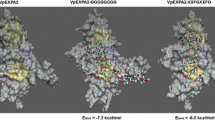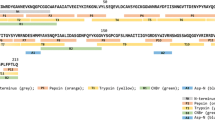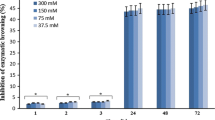Abstract
Fruit bromelain is a cysteine protease accumulated in pineapple fruits. This proteolytic enzyme has received high demand for industrial and therapeutic applications. In this study, fruit bromelain sequences QIM61759, QIM61760 and QIM61761 were retrieved from the National Center for Biotechnology Information (NCBI) Genbank Database. The tertiary structure of fruit bromelain QIM61759, QIM61760 and QIM61761 was generated by using MODELLER. The result revealed that the local stereochemical quality of the generated models was improved by using multiple templates during modelling process. Moreover, by comparing with the available papain model, structural analysis provides an insight on how pro-peptide functions as a scaffold in fruit bromelain folding and contributing to inactivation of mature protein. The structural analysis also disclosed the similarities and differences between these models. Lastly, thermal stability of fruit bromelain was studied. Molecular dynamics simulation of fruit bromelain structures at several selected temperatures demonstrated how fruit bromelain responds to elevation of temperature.














Similar content being viewed by others
Abbreviations
- Dope:
-
Discrete optimized protein energy
- GROMACS:
-
GROningen MAchine for Chemical Simulations
- LINCS:
-
Linear Constraint Solver
- MD:
-
Molecular dynamics
- NCBI:
-
National Center for Biotechnology Information
- NPT:
-
Constant number of particles, pressure and temperature
- NVT:
-
Constant number of particles, volume and temperature
- PDB ID:
-
Protein Data Bank identification
- PME:
-
Particle mesh Ewald method
- Rg:
-
Radius of gyration
- RMSD:
-
Root-mean-square deviations.
- RMSF:
-
Root-mean-square fluctuations
- SASA:
-
Solvent accessible surface area
References
Jisha VN, Smitha RB, Pradeep S et al (2013) Versatility of microbial proteases. Adv Enzym Res 1(3):39–51. https://doi.org/10.4236/aer.2013.13005
Mahajan RT, Badgujar SB (2010) Biological aspects of proteolytic enzymes : a review. J Pharm Res 3(9):2048–2068
Chew LY, Toh GT, Ismail A (2018) Application of proteases for the production of bioactive peptides. In: Kuddus M (ed) Enzymes in food biotechnology. Elsevier, London, pp 247–261
Kwon CW, Park KM, Kang BC et al (2015) Cysteine protease profiles of the medicinal plant Calotropis procera R. Br. revealed by de Novo transcriptome analysis. PLoS One 10(3):1–15. https://doi.org/10.1371/journal.pone.0119328
Lin E, Burns DJW, Gardner RC (1993) Fruit developmental regulation of the kiwifruit actinidin promoter is conserved in transgenic petunia plants. Plant Mol Biol 23(3):489–499. https://doi.org/10.1007/BF00019297
Ramalingam C, Srinath R, Islam NN (2012) Isolation and characterization of bromelain from pineapple (Ananas comosus) and comparing its anti-browning activity on apple juice with commercial anti- browning agents. Elixir Food Sci 45:7822–7826
Bresolin IRAP, Bresolin ITL, Silveira E, Tambourgi EB, Mazzola PG (2013) Isolation and purification of bromelain from waste peel of pineapple for therapeutic application. Braz Arch Biol Technol 56(6):971–979. https://doi.org/10.1590/S1516-89132013000600012
da Silva LR (2017) Debridement applications of bromelain: a complex of cysteine proteases from pineapple. Adv Biotechnol Microbiol 3(5):6109–6111. https://doi.org/10.19080/AIBM.2017.03.555624
Maurer HR (2001) Bromelain: biochemistry, pharmacology and medical use. Cell Mol Life Sci 58(9):1234–1245. https://doi.org/10.1007/PL00000936
Rathnavelu V, Alitheen N, Sohila S et al (2016) Potential role of bromelain in clinical and therapeutic applications (review). Biomed Rep 5(3):283–288
Muhammad ZA, Ahmad T (2017) Therapeutic uses of pineapple-extracted bromelain in surgical care — a review. J Pak Med Assoc 67(1):121–125
Kelly G (1996) Bromelain: a literature review and discussion of its therapeutic applications. Altern Med Rev 11(44):243–257
Manzoor Z, Nawaz A, Mukhtar H, Haq I (2016) Bromelain: methods of extraction, purification and therapeutic applications. Braz Arch Biol Technol 59:1–16. https://doi.org/10.1590/1678-4324-2016150010
Wali N (2019) Pineapple (Ananas comosus). In: Nabavi S, Silva A (eds) Nonvitamin and nonmineral nutritional supplements. Elsevier, London, pp 367–373
Bhattacharyya BK (2008) Bromelain: an overview. Nat Prod Radiance 7(4):359–363
Pavan R, Jain S, Shraddha KA (2012) Properties and therapeutic application of bromelain: a review. Biotechnol Res Int 2012:1–6
Manohar J, Gayathri R, Vishnupriya V (2016) Tenderisation of meat using bromelain from pineapple extract. Int J Pharm Sci Rev Res 39(1):81–85
Han J, Cai Y, Xie X et al (2018) A simple method for purification of bromelain in a thermosensitive triblock copolymer-based protection system and recycling of phase components. Sep Sci Technol 53(4):636–644. https://doi.org/10.1080/01496395.2017.1398757
Heredia-Sandoval NG, Valencia-Tapia MY, de la Barca AMC, Islas-Rubio AR (2016) Microbial proteases in baked goods: modification of gluten and effects on immunogenicity and product quality. Foods 5(3):1–10. https://doi.org/10.3390/foods5030059
Nair IC, Jayachandran K (2019) Aspartic proteases in food industry. In: Parameswaran B, Varjani S, Raveendran S (eds) Green bio-processes: enzymes in industrial food processing. Springer, Singapore, pp 15–30
Ismail B, Mohammed H, Nair AJ (2019) Influence of proteases on functional properties of food. In: Parameswaran B, Varjani S, Raveendran S (eds) Green bio-processes: enzymes in industrial food processing. Springer, Singapore, pp 31–53
Mihasan M (2010) Basic protein structure prediction for the biologist: a review. Arch Biol Sci 62(4):857–871. https://doi.org/10.2298/ABS1004857M
Pavlopoulou A, Michalopoulos I (2011) State-of-the-art bioinformatics protein structure prediction tools (review). Int J Mol Med 289(3):295–310. https://doi.org/10.3892/ijmm.2011.705
Ganugapati J, Akash S (2017) Multi-template homology based structure prediction and molecular docking studies of protein ‘L’ of Zaire ebolavirus (EBOV). Inform Med Unlocked 9:68–75. https://doi.org/10.1016/j.imu.2017.06.002
Chakravarty S, Godbole S, Zhang B, Berger S, Sanchez R (2008) Accuracy of comparative models of protein structure. BMC Struct Biol 8(31):1–13. https://doi.org/10.1186/1472-6807-8-31
Ramli ANM, Manas NHA, Hamid AAA, Hamid HA, Illias RM (2018) Comparative structural analysis of fruit and stem bromelain from Ananas comosus. Food Chem 266:183–191. https://doi.org/10.1016/j.foodchem.2018.05.125
Sali A, Blundell TL (1993) Comparative protein modelling by satisfaction of spatial restraints. J Mol Biol 234(3):779–815. https://doi.org/10.1006/jmbi.1993.1626
Heo L, Feig M (2018) PREFMD: a web server for protein structure refinement via molecular dynamics simulations. Bioinformatics 34(6):1063–1065. https://doi.org/10.1093/bioinformatics/btx726
Abraham MJ, Murtola T, Schulz R et al (2015) Gromacs: high performance molecular simulations through multi-level parallelism from laptops to supercomputers. SoftwareX 1–2:19–25. https://doi.org/10.1016/j.softx.2015.06.001
Feig M (2016) Local rotein structure refinement via molecular dynamics simulations with locPREFMD. J Chem Inf Model 56(7):1304–1312. https://doi.org/10.1021/acs.jcim.6b00222
Huang J, Rauscher S, Nawrocki G et al (2016) CHARMM36m: an improved force field for folded and intrinsically disordered proteins. Nat Methods 14(1):71–73. https://doi.org/10.1038/nmeth.4067
Bowie JU, Ltcy R, Eisenberg D (1991) A method to identify protein sequences that fold into a known three-dimensional structure. Science 253(58):164–170. https://doi.org/10.1126/science.1853201
Colovos C, Yeates TO (1993) Verification of protein structures: patterns of nonbonded atomic interactions. Protein Sci 2(9):1511–1519. https://doi.org/10.1002/pro.5560020916
Laskowski RA, MacArthur MW, Moss DS, Thornton JM (1993) PROCHECK - a program to check the stereochemical quality of protein structures. J Appl Crystallogr 26:283–291
Guex N, Peitsch MC (1997) SWISS-MODEL and the Swiss-PdbViewer: an environment for comparative protein modeling. Electrophoresis 18(15):2714–2723. https://doi.org/10.1002/elps.1150181505
Al-Sa’ady A, Al-Hadban W, Al-Zubaidy M (2016) Optimal conditions for bromelain extraction from pineapple fruit (Ananas comosus). Eng Technol J 34(5):675–682
Cupp-enyard C, Sigma-Aldrich (2008) Sigma’s non-specific protease activity assay-casein as a substrate. J Vis Exp 19:1–2
Dorn M, Silva MBE, Buriol LS, Lamb LC (2014) Three-dimensional protein structure prediction: methods and computational strategies. Comput Biol Chem 53:251–276. https://doi.org/10.1016/j.compbiolchem.2014.10.001
Meier A, Söding J (2015) Automatic prediction of protein 3D structures by probabilistic multi-template homology modeling. PLoS Comput Biol 11(10):1–20. https://doi.org/10.1371/journal.pcbi.1004343
Li J, Cheng J (2016) A stochastic point cloud sampling method for multi-template protein comparative modeling. Sci Rep 6:1–16. https://doi.org/10.1038/srep25687
Ishitani R, Terada T, Shimizu K (2008) Refinement of comparative models of protein structure by using multicanonical molecular dynamics simulations. Mol Simul 34(3):327–336. https://doi.org/10.1080/08927020801930539
Park H, Ovchinnikov S, Kim DE, DiMaio F, Baker D (2018) Protein homology model refinement by large-scale energy optimization. Proc Natl Acad Sci 115(12):3054–3059. https://doi.org/10.1073/pnas.1719115115
Feig M (2017) Computational protein structure refinement: almost there, yet still so far to go. Wiley Interdiscip Rev Comput Mol Sci 7(3):1–16. https://doi.org/10.1002/wcms.1307
Heo L, Feig M (2018) Experimental accuracy in protein structure refinement via molecular dynamics simulations. Proc Natl Acad Sci 115(52):13276–13281. https://doi.org/10.1073/pnas.1811364115
Raval A, Piana S, Eastwood MP, Dror RO, Shaw DE (2012) Refinement of protein structure homology models via long, all-atom molecular dynamics simulations. Proteins 80(8):2071–2079. https://doi.org/10.1002/prot.24098
Lobanov MY, Bogatyreva NS, Galzitskaya OV (2008) Radius of gyration as an indicator of protein structure compactness. Mol Biol 42(4):623–628. https://doi.org/10.1134/S0026893308040195
Dinner AR, Sali A, Smith LJ, Dobson CM, Karplus M (2000) Understanding protein folding via free-energy surfaces from theory and experiment. Trends Biochem Sci 25(7):331–339. https://doi.org/10.1016/S0968-0004(00)01610-8
Tsai J, Bonneau R, Av M, Kuhlman B, Rohl CA, Baker D (2003) An improved protein decoy set for testing energy functions for protein structure prediction. Proteins Struct Funct Genet 53(1):76–87. https://doi.org/10.1002/prot.10454
Dong R, Pan S, Peng Z, Zhang Y, Yang J (2018) mTM-align : a server for fast protein structure database search and multiple protein structure alignment. Nucleic Acids Res 46:380–386. https://doi.org/10.1093/nar/gky430
Haimov B, Srebnik S (2016) A closer look into the α-helix basin. Sci Rep 6:1–12. https://doi.org/10.1038/srep38341
Pace CN, Scholtz JM (1998) A helix propensity scale based on experimental studies of peptides and proteins. Biophys J 75(1):422–427. https://doi.org/10.1016/s0006-3495(98)77529-0
Merkel JS, Strutevant JM, Regan L (1999) Sidechain interactions in parallel β sheets: the energetics of cross-strand pairings. Structure 7(11):1333–1343. https://doi.org/10.1016/S0969-2126(00)80023-4
Groves MR, Taylor MAJ, Scott M, Cummings NJ, Pickersgill RW, Jenkins JA (1996) The prosequence of procaricain forms an α-helical domain that prevents access to the substrate-binding cleft. Structure 4(10):1193–1203. https://doi.org/10.1016/S0969-2126(96)00127-X
Roy S, Choudhury D, Aich P, Dattagupta JK, Biswas S (2012) The structure of a thermostable mutant of pro-papain reveals its activation mechanism. Acta Crystallogr Sect D Biol Crystallogr 68(12):1591–1603. https://doi.org/10.1107/s0907444912038607
Turk V, Stoka V, Vasiljeva O et al (2012) Cysteine cathepsins: from structure, function and regulation to new frontiers. Biochim Biophys Acta Proteins Proteomics 1824(1):68–88. https://doi.org/10.1016/j.bbapap.2011.10.002
Amri E, Mamboya F (2012) Papain, a plant enzyme of biological importance: a review. Am J Biochem Biotechnol 8(2):99–104. https://doi.org/10.3844/ajbbsp.2012.99.104
Menard R, Carriere J, Laflamme P et al (1991) Contribution of the glutamine 19 side chain to transition-state stabilization in the oxyanion hole of papain. Biochemistry 30(37):8924–8928
Coulombe R, Grochulski P, Sivaraman J, Ménard R, Mort JS, Cygler M (1996) Structure of human procathepsin L reveals the molecular basis of inhibition by the prosegment. EMBO J 15(20):5492–5503. https://doi.org/10.1002/j.1460-2075.1996.tb00934.x
Sokalingam S, Raghunathan G, Soundrarajan N, Lee SG (2012) A study on the effect of surface lysine to arginine mutagenesis on protein stability and structure using green fluorescent protein. PLoS One 7(7):1–12. https://doi.org/10.1371/journal.pone.0040410
Zou Z, Huang Q, Xie G, Yang L (2018) Genome-wide comparative analysis of papain-like cysteine protease family genes in castor bean and physic nut. Sci Rep 8(1):1–13. https://doi.org/10.1038/s41598-017-18760-6
Butts CT, Zhang X, Kelly JE et al (2016) Sequence comparison, molecular modeling, and network analysis predict structural diversity in cysteine proteases from the Cape sundew, Drosera capensis. Comput Struct Biotechnol J 14:271–282. https://doi.org/10.1016/j.csbj.2016.05.003
Verma S, Dixit R, Pandey KC (2016) Cysteine proteases: modes of activation and future prospects as pharmacological targets. Front Pharmacol 7(107):1–12. https://doi.org/10.3389/fphar.2016.00107
Jutamongkon R, Charoenrein S (2010) Effect of temperature on the stability of fruit bromelain from smooth Cayenne pineapple. Kasetsart J (Nat Sci) 44:943–948
Robinson PK (2015) Enzymes: principles and biotechnological applications. Essays Biochem 59:1–41. https://doi.org/10.1042/bse0590075
Fields PA, Dong Y, Meng X, Somero GN Adaptations of protein structure and function to temperature: there is more than one way to ‘skin a cat’. J Exp Biol 218(12):1801–1811. https://doi.org/10.1242/jeb.114298
Ab S, Rahim ASMA, Rahman RNZRA, Leow TC, Basri M (2012) The role of Arg157Ser in improving the compactness and stability of ARM lipase. J Comput Sci Syst Biol 5(2):39–46. https://doi.org/10.4172/jcsb.1000088
Kato K, Nakayoshi T, Fukuyoshi S, Kurimoto E, Oda A (2017) Validation of molecular dynamics simulations for prediction of three-dimensional structures of small proteins. Molecules 22(10):1–15. https://doi.org/10.3390/molecules22101716
Paul M, Hazra M, Barman A, Hazra S (2014) Comparative molecular dynamics simulation studies for determining factors contributing to the thermostability of chemotaxis protein ‘CheY’. J Biomol Struct Dyn 32(6):928–949. https://doi.org/10.1080/07391102.2013.799438
Gu J, Tong H, Sun L, Lin Z (2019) Molecular dynamics perspective on the thermal stability of mandelate racemase. J Biomol Struct Dyn 37(2):383–393. https://doi.org/10.1080/07391102.2018.1427631
Wu X, Xu P, Wang J et al (2015) Folding mechanisms of trefoil knot proteins studied by molecular dynamics simulations and go-model. In: Wei D, Xu Q, Zhao T, Dai H (eds) Advance in structural bioinformatics. Springer Netherlands, Dordrecht, pp 93–110
Camilloni C, Bonetti D, Morrone A et al (2016) Towards a structural biology of the hydrophobic effect in protein folding. Sci Rep 6:1–9. https://doi.org/10.1038/srep28285
Pucci F, Rooman M (2017) Physical and molecular bases of protein thermal stability and cold adaptation. Curr Opin Struct Biol 42:117–128. https://doi.org/10.1016/j.sbi.2016.12.007
Rosa M, Roberts CJ, Rodrigues MA (2017) Connecting high-temperature and low temperature protein stability and aggregation. PLoS One 12(5):1–12. https://doi.org/10.1371/journal.pone.0176748
Mishra A, Ranganathan S, Jayaram B, Sattar A (2018) Role of solvent accessibility for aggregation-prone patches in protein folding. Sci Rep 8(1):1–13 https://doi.org/10.1038/s41598-018-31289-6
Daniel RM, Dines M, Petach HH (1996) The denaturation and degradation of stable enzymes at high temperatures. Biochem J 317(1):1–11. https://doi.org/10.1042/bj3170001
Pace CN, Fu H, Fryar KL et al (2014) Contribution of hydrogen bonds to protein stability. Protein Sci 23(5):652–661. https://doi.org/10.1002/pro.2449
Gao Y, Mei Y, Zhang JZH (2015) Treatment of hydrogen bonds in protein simulations. In: Liu J (ed) Advanced materials for renewable hydrogen production, storage and utilization. In Tech, Rijeka, pp 111–136
Mukherjee S, Majumdar S, Bhattacharyya D (2005) Role of hydrogen bonds in protein-DNA recognition: effect of nonplanar amino groups. J Phys Chem B 109(20):10484–10492. https://doi.org/10.1021/jp0446231
Vogt G, Argos P (1997) Protein thermal stability: hydrogen bonds or internal packing? Fold Des 2(4):40–46. https://doi.org/10.1016/S1359-0278(97)00062-X
Mallamace D, Fazio E, Mallamace F, Corsaro C (2018) The role of hydrogen bonding in the folding/unfolding process of hydrated lysozyme: a review of recent NMR and FTIR results. Int J Mol Sci 19(12):1–21. https://doi.org/10.3390/ijms19123825
Ning X, Zhang Y, Yuan T et al (2018) Enhanced thermostability of glucose oxidase through computer-aided molecular design. Int J Mol Sci 19(2):1–11. https://doi.org/10.3390/ijms19020425
Du X, Sang P, Xia Y et al (2017) Comparative thermal unfolding study of psychrophilic and mesophilic subtilisin-like serine proteases by molecular dynamics simulations. J Biomol Struct Dyn 35(7):1500–1517. https://doi.org/10.1080/07391102.2016.1188155
Burgos MI, Ochoa A, Perillo MA (2019) β-Sheet to α-helix conversion and thermal stability of β-galactosidase encapsulated in a nanoporous silica gel. Biochem Biophys Res Commun 508(1):270–274. https://doi.org/10.1016/j.bbrc.2018.11.077
Emberly EG, Mukhopadhyay R, Wingreen NS, Tang C (2003) Flexibility of α-helices: results of a statistical analysis of database protein structures. J Mol Biol 327(1):229–237. https://doi.org/10.1016/S0022-2836(03)00097-4
Chaturvedi D, Mahalakshmi R (2017) Transmembrane β-barrels evolution, folding and energetics. Biochim Biophys Acta Biomembr 1859(12):2467–2482. https://doi.org/10.1016/j.bbamem.2017.09.020
Perczel S, Gaspari Z, Csizmadia IG (2005) Structure and stability of the beta-pleated sheets. J Comput Chem 26(11):1155–1168. https://doi.org/10.1002/jcc.20255
Gessmann D, Mager F, Naveed H et al (2011) Improving the resistance of a eukaryotic β-barrel protein to thermal and chemical perturbations. J Mol Biol 413(1):150–161. https://doi.org/10.1016/j.jmb.2011.07.054
Cebe P, Hu X, Kaaplan DL et al (2013) Beating the heat-fast scanning melts silk beta sheet crystals. Sci Rep 3:1–7. https://doi.org/10.1038/srep01130
Ahmad S, Kumar V, Ramanand KB, Rao NM (2012) Probing protein stability and proteolytic resistance by loop scanning: a comprehensive mutational analysis. Protein Sci 21(3):433–446. https://doi.org/10.1002/pro.2029
Zeiske T, Stafford KA, Palmer III AG (2016) Thermostability of enzymes from molecular dynamics simulations. J Chem Theory Comput 12(6):2489–2492. https://doi.org/10.1021/acs.jctc.6b00120
Shehu A, Kavraki LE (2012) Modeling structures and motions of loops in protein molecules. Entropy 14(2):252–290. https://doi.org/10.3390/e14020252
Yedavalli P, Rao NM (2013) Engineering the loops in a lipase for stability in DMSO. Protein Eng Des Sel 26(4):317–324. https://doi.org/10.1093/protein/gzt002
Yu H, Yan Y, Zhang C, Dalby PA (2017) Two strategies to engineer flexible loops for improved enzyme thermostability. Sci Rep 7:1–15. https://doi.org/10.1038/srep41212
Wintrode PL, Zhang D, Vaidehi N, Arnold FH, Goddard WA (2003) Protein dynamics in a family of laboratory evolved thermophilic enzymes. J Mol Biol 327(3):745–757. https://doi.org/10.1016/S0022-2836(03)00147-5
Chang HJ, Jian JW, Hsu HJ et al (2014) Loop-sequence features and stability determinants in antibody variable domains by high-throughput experiments. Structure 22(1):9–21. https://doi.org/10.1016/j.str.2013.10.005
Wong SWK, Liu JS, Kou SC (2017) Fast de novo discovery of low-energy protein loop conformations. Proteins Struct Funct Bioinf 85(8):1402–1412. https://doi.org/10.1002/prot.25300
Alvarez-Ponce D, Ruiz-González MX, Vera-Sirera F, Feyertag F, Perez-Amador MA, Fares MA (2018) Arabidopsis heat stress-induced proteins are enriched in electrostatically charged amino acids and intrinsically disordered regions. Int J Mol Sci 19(8):1–15. https://doi.org/10.3390/ijms19082276
Sosa-Pagán JO, Iversen ES, Grandl J (2017) TRPV1 temperature activation is specifically sensitive to strong decreases in amino acid hydrophobicity. Sci Rep 7(1):1–10. https://doi.org/10.1038/s41598-017-00636-4
Szilágyi A, Závodszky P (2000) Structural differences between mesophilic, moderately thermophilic and extremely thermophilic protein subunits: results of a comprehensive survey. Structure 8:493–504
Ramli ANM, Mahadi NM, Shamsir MS et al (2012) Structural prediction of a novel chitinase from the psychrophilic Glaciozyma antarctica PI12 and an analysis of its structural properties and function. J Comput Aided Mol Des 26(8):947–961. https://doi.org/10.1007/s10822-012-9585-7
Sinha R, Khare SK (2013) Thermostable protease. In: Satyanarayana T, Littlechild J, Kawarabayasi Y (eds) Thermophilic microbes in environmental and industrial biotechnology: biotechnology of thermophiles. Springer, Heidelberg, pp 859–880
Brewer SH, Tang Y, Vu DM, Gnanakaran S, Raleigh DP, Dyer RB (2012) Temperature dependence of water interactions with the amide carbonyls of α-helices. Biochemistry 51(26):5293–5299. https://doi.org/10.1021/bi3006434
Kazlauskas R (2018) Engineering more stable proteins. Chem Soc Rev 47(24):9026–9045. https://doi.org/10.1039/c8cs00014j
Russell RJM, Ferguson JMC, Hough DW, Danson MJ, Taylor GL (1997) The crystal structure of citrate synthase from the hyperthermophilic archaeon Pyrococcus furiosus at 1.9 Å resolution. Biochemistry 36(33):9983–9994. https://doi.org/10.1021/bi9705321
Kumar V, Sharma N, Bhalla TC (2014) In silico analysis of β-galactosidases primary and secondary structure in relation to temperature adaptation. J Amino Acids 2014:1–9. https://doi.org/10.1155/2014/475839
Ramli ANM, Azhar MA, Shamsir MS et al (2013) Sequence and structural investigation of a novel psychrophilic α-amylase from Glaciozyma antarctica PI12 for cold-adaptation analysis. J Mol Model 19(8):2013. https://doi.org/10.1007/s00894-013-1861-5
Yennamalli RM, Rader AJ, Wolt JD, Sen TZ (2011) Thermostability in endoglucanases is fold-specific. BMC Struct Biol 11(10):1–15. https://doi.org/10.1186/1472-6807-11-10
Funding
This research was supported by the Universiti Malaysia Pahang through research grants RDU180345 and PGRS180362.
Author information
Authors and Affiliations
Corresponding author
Additional information
Publisher’s note
Springer Nature remains neutral with regard to jurisdictional claims in published maps and institutional affiliations.
Electronic supplementary material
ESM 1
(DOCX 1859 kb)
Rights and permissions
About this article
Cite this article
Pang, W.C., Ramli, A.N.M. & Hamid, A.A.A. Comparative modelling studies of fruit bromelain using molecular dynamics simulation. J Mol Model 26, 142 (2020). https://doi.org/10.1007/s00894-020-04398-1
Received:
Accepted:
Published:
DOI: https://doi.org/10.1007/s00894-020-04398-1




